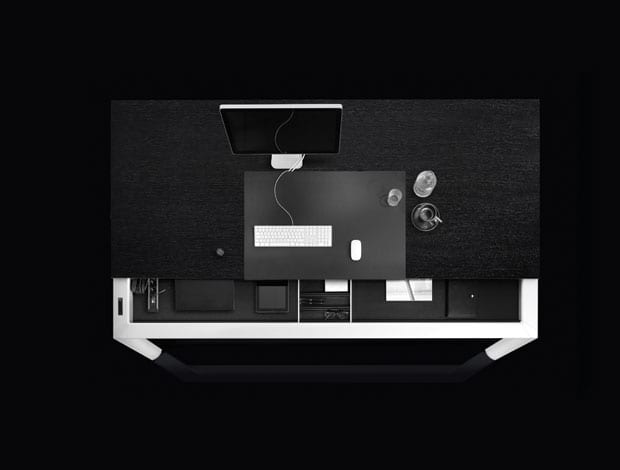 Bene’s AL range combines high-end finishes such as leather, oak and glass with modern functions|USM’s Haller meeting table and desk range – shown here in black lacquered oak – was designed in 1965 and is still a top seller|By Bailey captures the attention of Mad Men fans with luxurious designs like Gunlocke’s Credentials range|Walter Knoll’s Keypiece Communication desk is flexible enough for single-person working or for a small meeting||
Bene’s AL range combines high-end finishes such as leather, oak and glass with modern functions|USM’s Haller meeting table and desk range – shown here in black lacquered oak – was designed in 1965 and is still a top seller|By Bailey captures the attention of Mad Men fans with luxurious designs like Gunlocke’s Credentials range|Walter Knoll’s Keypiece Communication desk is flexible enough for single-person working or for a small meeting||
The executive office is still with us, but its furniture is changing. Still out to impress with size and spec, it also endorses the possibility of mutual space
It’s a market that seems at odds with flat hierarchies and agile workspace, but executive high-end workplace furniture is still being sold and specified by the lorry-full. Despite increasing amounts of CEOs and managers abandoning their private offices to sit proudly amid their staff (perhaps to their dismay), there clearly remains a strong demand for high-end office furniture, which signifies that many aren’t quite ready to give up their enclave just yet. However, with space at a premium, and younger staff expecting a more democratic and collaborative working culture, the market is changing tack.
“Ask any executive whether they want a high-end stylish private office or to work open plan, and deep down, we all know how the majority would respond,” says Steve Fitch, director at furniture supplier Dovetail. But that mentality shows signs of waning as the next generation takes over. Fitch believes there will always be a market for executive furniture, but it has decreased due to real estate cost and technological advances (promoting mobile working, for example), so private offices have become multipurpose.
“Even though there are fewer cellular offices, the expenditure per office has increased to create a multi-use private space,” he says. “Executives understand the potential space and cost wastage of a high-end cellular office sitting empty, and are therefore open for it to be used by others for meetings, presentations, or even being shared.”
These rooms often feature soft areas for informal meetings, large tables for formal meetings and desks for private working, but all of a higher specification – a middle ground that still provides senior level staff with somewhere to impress clients.
The discrepancies between client sectors are also more noticeable at the high end. Advertising agencies, for example, are wholeheartedly embracing agile workspace because their working process is largely creative, meaning employees are away from their desks brainstorming and collaborating (and playing ping pong). The financial and legal sectors, meanwhile, are still largely entrenched in hierarchical systems, while still accommodating space-efficiency and mobile working. According to Kinnarps’ Marc Bird, the compromise is often furniture with contemporary functions yet lavish finishes like solid wood and leather.
“Even though there are fewer cellular offices, the expenditure per office has increased to create a multi-use private space
“The move to open plan has had a massive effect on this industry,” he says. “Senior employees use their furniture far less to mark their territory. We’re seeing a more subtle expression of success, using more consistent furniture ranges across a floorplan but ‘speccing up’ for senior positions.”So, while staff might have a laminated desk such as Kinnarps’ Oberon, the boss might go for the same in a dark veneer.
Bene has recently extended its AL executive range to include finishes such as anodised black aluminium, leather, oak and heavyweight glass. The designs also incorporate power sockets and docking stations underneath the tabletop, allowing for both team and individual working, and height-adjustability. With its tapered tabletop, German brand Walter Knoll’s Keypiece Communication Desk is designed to have a ‘private zone’ for individual work at the narrower end as well as a ‘meeting zone’ for small gatherings at the other.
Hands furniture, an established furniture brand well versed in the needs of executive clients, has also noticed an upswing in the demand for opulent materials. “Feedback from the high-end shows a resurgent desire for classic natural materials, like real wood veneer and hide, but with a contemporary design edge,” says the firm’s Paul Alexander. He says the company has focused on its executive ranges in recent years and has seen significant growth in domestic and export markets, with demand across various client types from retail to engineering and pharmaceutical.
New furniture supplier By Bailey is also cashing in on a strong high-end market.
“Collaboration within shared spaces is the fashion today, but should not be seen as the norm,” says founder Mark Bailey. “Placing a pod in the centre of an office isn’t the only answer.”
“Collaboration within shared spaces is the fashion today, but should not be seen as the norm”
He says the pursuit of reducing footprint and following trends has sometimes overshadowed the need for private space, which is often necessary. By Bailey launched during Clerkenwell Design Week and is concentrating purely on the top end. Its new showroom demonstrated its slant with executive ranges brought over from American brands Gunlocke and HBF and a strategically placed Mad Men box set on the shelves.
Despite often representing the antithesis of forward-thinking workplace design in the minds of many designers, Mad Men’s influence is unyielding. And while the market gradually shifts towards more modern sensibilities of flexible, democratic office life, it seems there is still a Don Draper/Peggy Olson inside many executives causing cravings for luxury at work – only now, it’s subtler, and the wealth trickles down a little further to the staff.






















